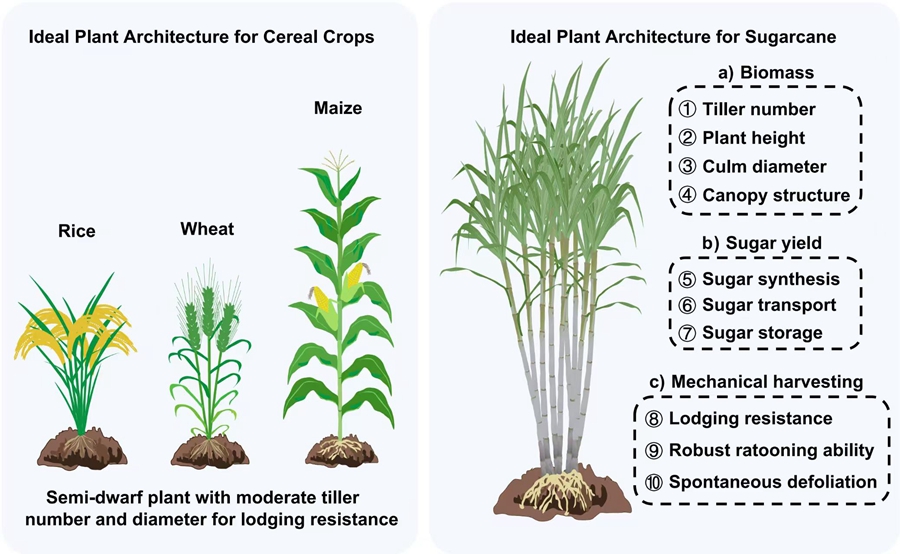Sugarcane (Saccharum spp. hybrid) is one of the world's most economically significant crops, contributing ~80% of global sugar production and 40% of fuel ethanol. Improving sugarcane yield is essential to ensure sugar security and promote bio-economic development. Plant architecture, the three-dimensional structural feature formed during morphogenesis, has a profound effect on crop yield and thus serves as a core element in high-yield breeding. However, due to limitations such as the highly complex sugarcane genome, narrow genetic background, and long breeding cycles, the dissection and application of architecture improvement in sugarcane breeding have lagged behind, leaving significant untapped potential for yield improvement.
In a study published in Molecular Plant on April 8, researchers led by Prof. WANG Bing from the Institute of Genetics and Developmental Biology (IGDB), Chinese Academy of Sciences (CAS), and Prof. LI Jiayang from the Yazhouwan National Laboratory/IGDB, proposed an innovative concept of "ideal plant architecture for sugarcane" and discuss the challenges, opportunities, and strategies for shaping it. This study provides new insights for achieving breakthroughs in sugarcane yields and has significant implications for ensuring global sugar security.
Ideal Plant Architecture (IPA) is the morphological and structural characteristics of plants that enable them to achieve maximum population potential in a given environment.
This concept was proposed by the group of the Chinese scientist LI Jiayang and further substantiated by the cloning of theIPA1gene in rice. It provides guidance and reference for genetic improvement and breeding by design in a wide range of crops. The shaping of sugarcane IPA must revolve around its growth characteristics and target economic traits, including maximizing stalk biomass, increasing sugar content, and adapting to efficient mechanized harvesting. The research team proposed the key characteristics of sugarcane IPA into six critical aspects: uniform tillering with minimal non-productive tillers, thick and upright stalks, optimized canopy structure, strong lodging resistance, robust ratooning ability, and spontaneous defoliation at maturity. The multi-dimensional optimization of these traits collectively provides the blueprint for high-yielding, efficient, and sustainable sugarcane production.
The theoretical yield potential of sugarcane is 380 t/ha, but the actual yield is around 80 t/ha, highlighting an urgent need for architectural improvement to narrow this gap. However, sugarcane's extraordinarily complex genome (exceeding 10 Gb with 100-130 chromosomes), limited genetic diversity, and long breeding cycles (8-12 years) severely constrain rapid architectural improvement.
Recent breakthroughs in genomics, phenomics, and genome editing technologies offer unprecedented opportunities for improving sugarcane architecture. High-quality reference genomes and pan-genome studies have laid the foundation for identifying architecture-regulating genes, and genome editing technology enables precise modulation of gene dosage in polyploid sugarcane. De novo domestication of wild sugarcane germplasm can rapidly develop new varieties with both desirable yield traits and high stress resistance. Molecular breeding by design allows targeted optimization of the architecture and can significantly improve breeding efficiency. Artificial intelligence is revolutionizing sugarcane breeding by integrating multi-source data and enabling accurate phenotype prediction. These innovative approaches will drive breakthroughs in sugarcane yield to ensure global sugar security and will also provide valuable references for architectural improvement and molecular breeding by design in other high-biomass, polyploid crops.
This study was supported by the Strategic Priority Research Program of the Chinese Academy of Sciences, the National Natural Science Foundation of China, and the Youth Innovation Promotion Association of the Chinese Academy of Science.
Ideal plant architecture for sugarcane and other cereal crops (Image by IGDB)
Contact:
Prof. WANG Bing
Institute of Genetics and Developmental Biology, Chinese Academy of Sciences
Email: bingwang@genetics.ac.cn
 Ideal plant architecture for sugarcane and other cereal crops (Image by IGDB)Contact:Prof. WANG BingInstitute of Genetics and Developmental Biology, Chinese Academy of SciencesEmail: bingwang@genetics.ac.cn
Ideal plant architecture for sugarcane and other cereal crops (Image by IGDB)Contact:Prof. WANG BingInstitute of Genetics and Developmental Biology, Chinese Academy of SciencesEmail: bingwang@genetics.ac.cn CAS
CAS
 中文
中文




.png)
